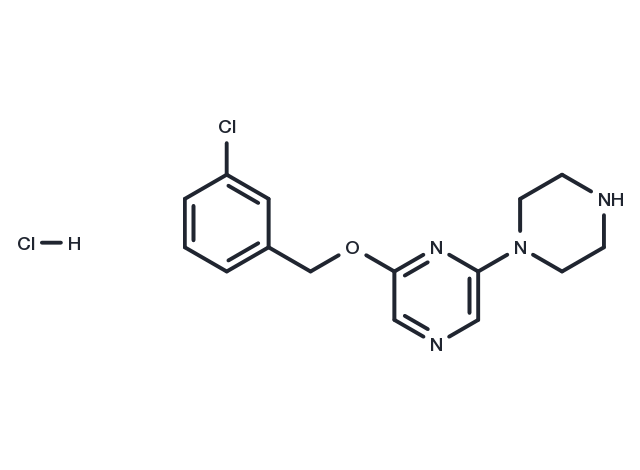Powder: -20°C for 3 years | In solvent: -80°C for 1 year


CP-809101 hydrochloride is a potent and selective 5-HT2C receptor agonist (pEC50: 9.96/7.19/6.81 for human 5-HT2C/5-HT2B/5-HT2A receptors).

| Pack Size | Availability | Price/USD | Quantity |
|---|---|---|---|
| 1 mg | In stock | $ 33.00 | |
| 2 mg | In stock | $ 46.00 | |
| 5 mg | In stock | $ 75.00 | |
| 10 mg | In stock | $ 117.00 | |
| 25 mg | In stock | $ 258.00 | |
| 50 mg | In stock | $ 479.00 | |
| 100 mg | In stock | $ 686.00 |

| Description | CP-809101 hydrochloride is a potent and selective 5-HT2C receptor agonist (pEC50: 9.96/7.19/6.81 for human 5-HT2C/5-HT2B/5-HT2A receptors). |
| Targets&IC50 | 5-HT2B:7.19(pEC50 for human), 5-HT2C:9.96(pEC50 for human), 5-HT2A:6.81(pEC50 for human) |
| In vitro | CP-809101 is a potent, functionally selective 5-HT2C agonist that displays approximately 100% efficacy in vitro[4]. |
| In vivo | Similar to currently available antipsychotic drugs, CP-809101 dose-dependently inhibited conditioned avoidance responding (CAR, ED50 = 4.8 mg/kg, sc). CP-809101 antagonized both PCP- and d-amphetamine-induced hyperactivity with ED50 values of 2.4 and 2.9 mg/kg (sc), respectively, and also reversed an apomorphine induced-deficit in prepulse inhibition. At doses up to 56 mg/kg, CP-809101 did not produce catalepsy. CP-809101 was inactive in two animal models of antidepressant-like activity, the forced swim test, and learned helplessness[4]. |
| Molecular Weight | 341.24 |
| Formula | C15H18Cl2N4O |
| CAS No. | 1215721-40-6 |
Powder: -20°C for 3 years | In solvent: -80°C for 1 year
H2O: 20 mg/mL (58.61 mM), Sonification is recommended.
You can also refer to dose conversion for different animals. More
bottom
Please see Inhibitor Handling Instructions for more frequently ask questions. Topics include: how to prepare stock solutions, how to store products, and cautions on cell-based assays & animal experiments, etc.
CP-809101 hydrochloride 1215721-40-6 GPCR/G Protein Neuroscience 5-HT Receptor CP809101 Hydrochloride CP 809101 hydrochloride hyperactivity nicotine dependence Inhibitor nicotine antipsychotic inhibit CP-809101 Serotonin Receptor CP809101 conditioned avoidance responding CP 809101 CP-809101 Hydrochloride CP 809101 Hydrochloride CP809101 hydrochloride 5-hydroxytryptamine Receptor inhibitor
